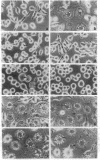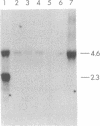Abstract
Analysis of a simian virus 40-immortalized colony-stimulating factor 1 (CSF-1) -dependent macrophage cell line (BAC1.2F5) and independently arising autonomous mutants derived from it (aut4A, aut4A.1, aut2A, and aut2A.1) revealed distinct phenotypes. The parental line, BAC1.2F5, is dependent on CSF-1 for survival and growth. Of the mutants derived from BAC1.2F5, aut4A has lost the requirement of CSF-1 for survival; aut4A.1 (derived from aut4A) and aut2A grow in the absence of growth factor but proliferate more rapidly in its presence, and aut2A.1 (derived from aut2A) produces CSF-1 and proliferates as rapidly in the presence as in the absence of exogeneous CSF-1. The separation of the CSF-1 requirement for survival and proliferation observed in aut4A is also observed in a temperature-sensitive (ts) mutant tsgro1. At the nonpermissive temperature, tsgro1 cell proliferation is arrested, but the cells survive provided CSF-1 is present. The four cellular phenotypes observed--immortalization, loss of growth factor requirement for survival, loss of growth factor requirement for proliferation, and loss of growth factor-stimulated proliferation--indicate a divergence of the pathways of growth factor-regulated survival and proliferation and may represent phenotypes occurring at intermediate stages in tumor-cell progression.
Full text
PDF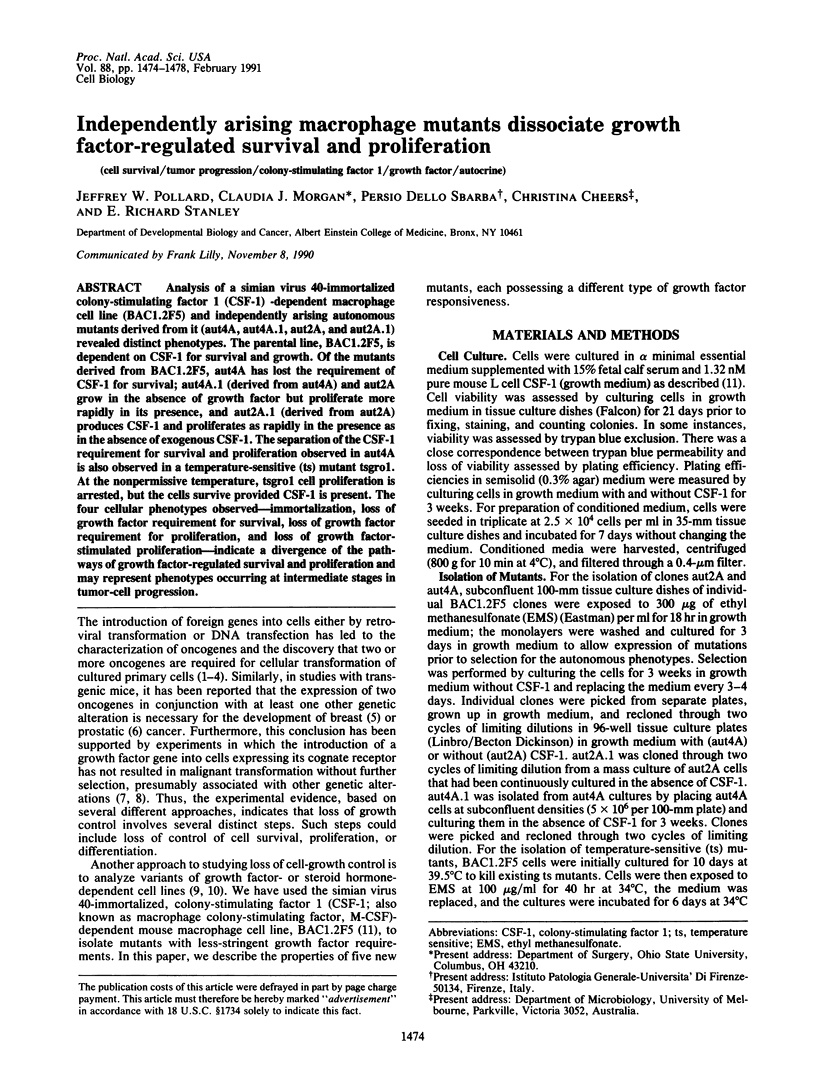
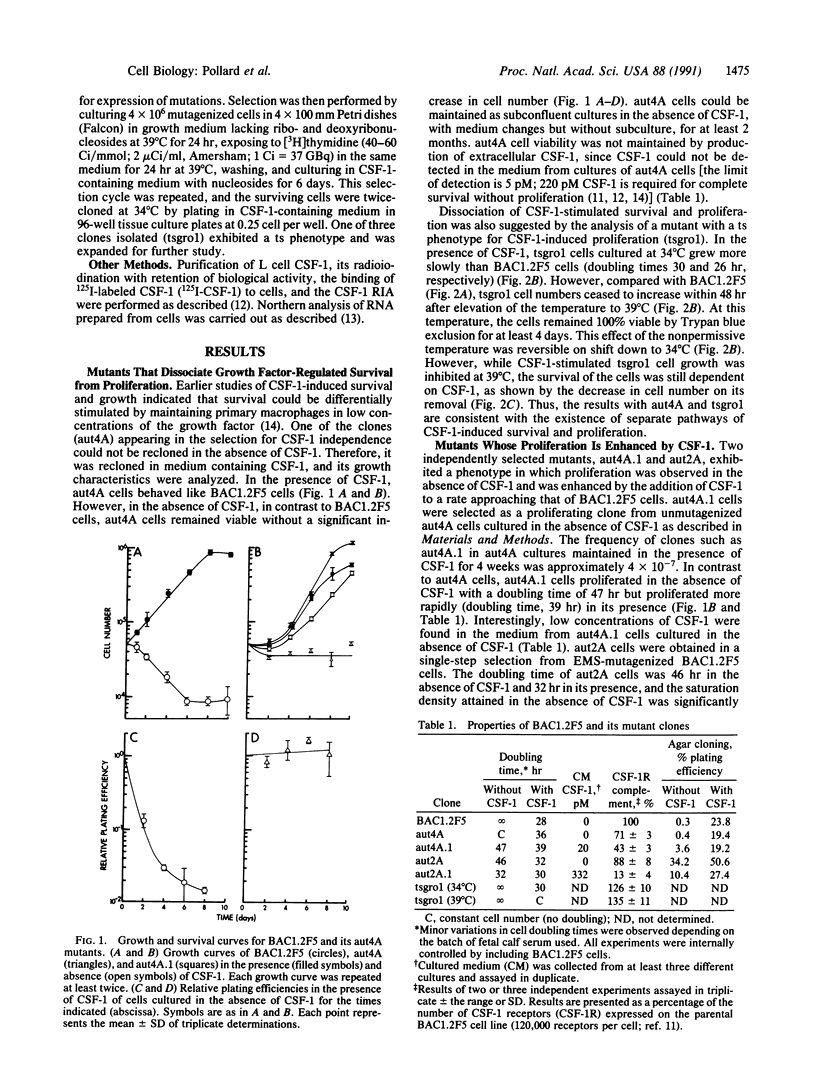
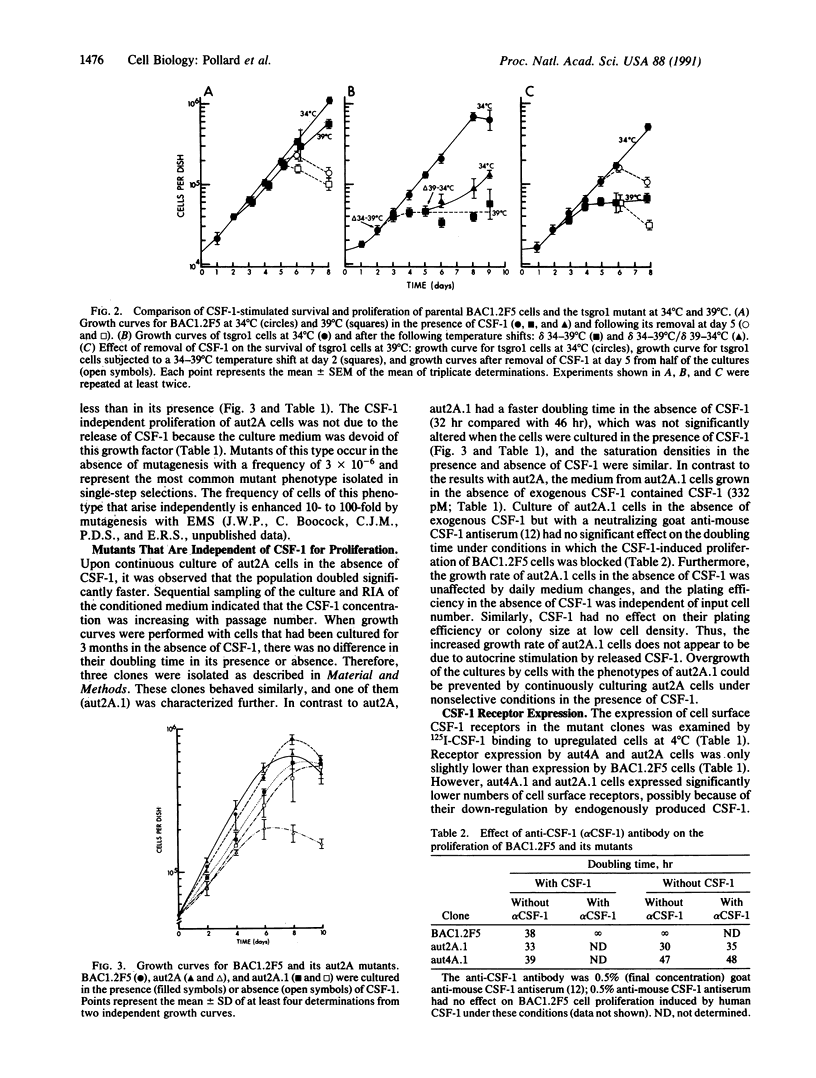
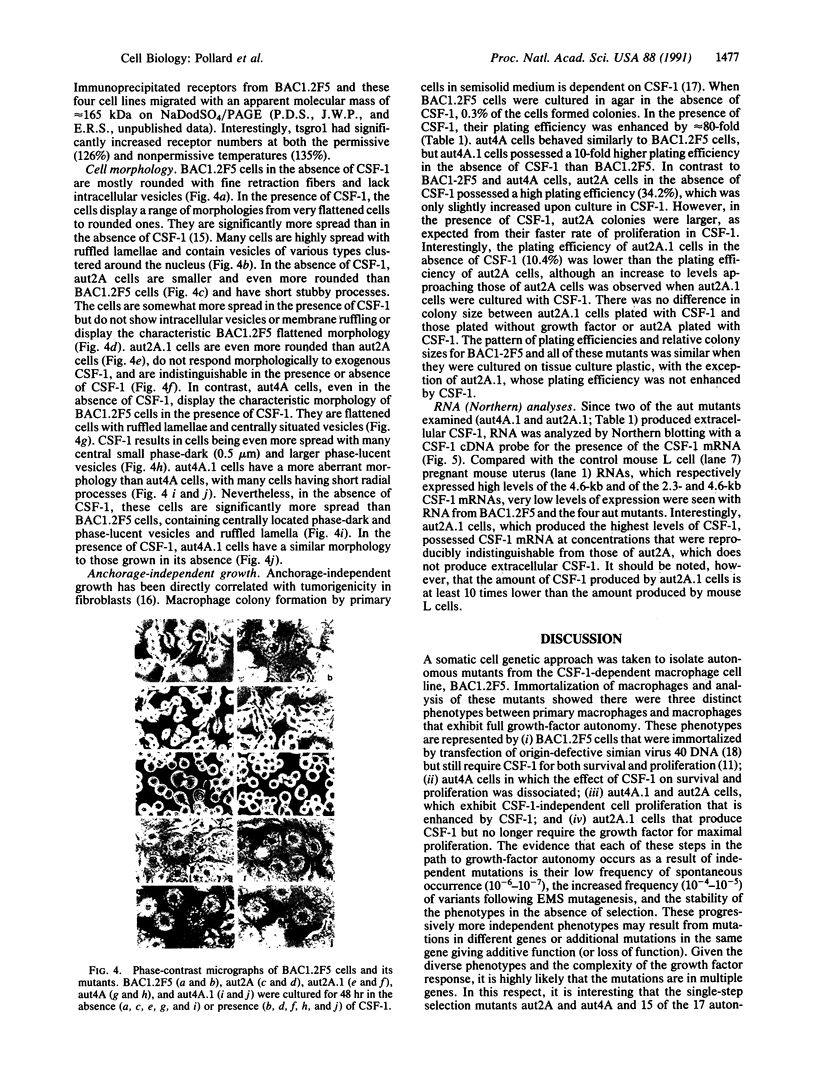
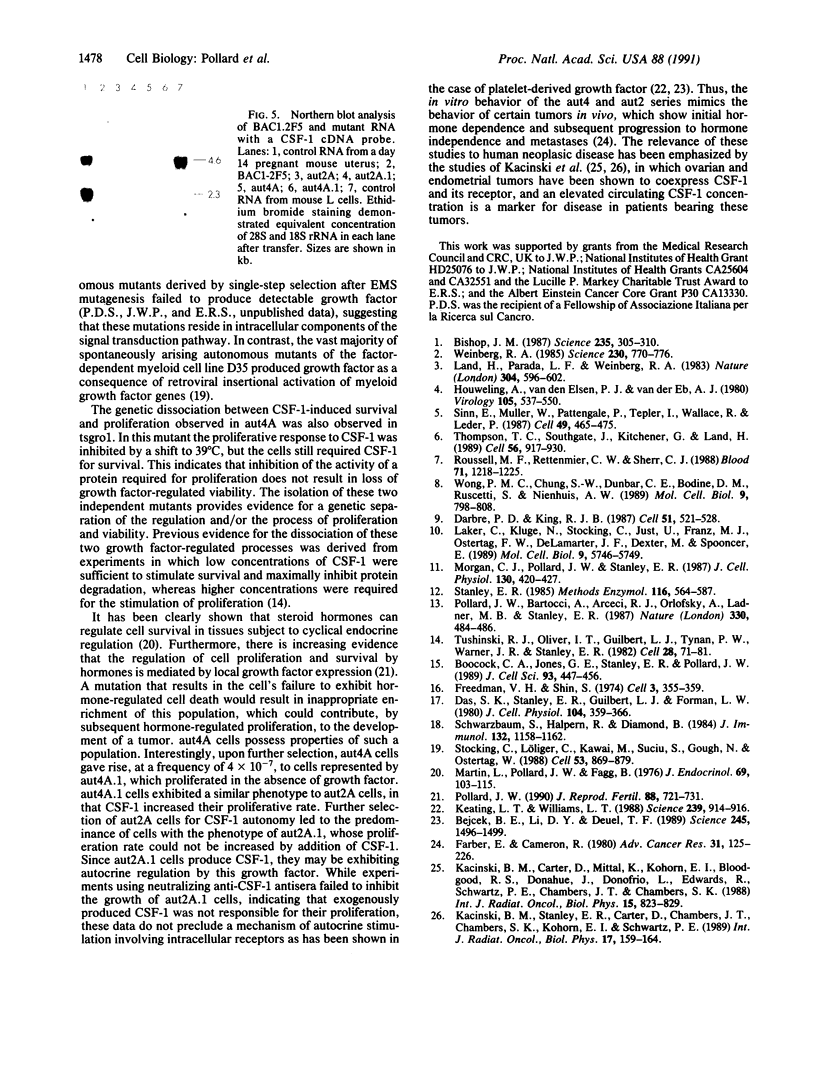
Images in this article
Selected References
These references are in PubMed. This may not be the complete list of references from this article.
- Bejcek B. E., Li D. Y., Deuel T. F. Transformation by v-sis occurs by an internal autoactivation mechanism. Science. 1989 Sep 29;245(4925):1496–1499. doi: 10.1126/science.2551043. [DOI] [PubMed] [Google Scholar]
- Bishop J. M. The molecular genetics of cancer. Science. 1987 Jan 16;235(4786):305–311. doi: 10.1126/science.3541204. [DOI] [PubMed] [Google Scholar]
- Boocock C. A., Jones G. E., Stanley E. R., Pollard J. W. Colony-stimulating factor-1 induces rapid behavioural responses in the mouse macrophage cell line, BAC1.2F5. J Cell Sci. 1989 Jul;93(Pt 3):447–456. doi: 10.1242/jcs.93.3.447. [DOI] [PubMed] [Google Scholar]
- Darbre P. D., King R. J. Progression to steroid insensitivity can occur irrespective of the presence of functional steroid receptors. Cell. 1987 Nov 20;51(4):521–528. doi: 10.1016/0092-8674(87)90121-8. [DOI] [PubMed] [Google Scholar]
- Das S. K., Stanley E. R., Guilbert L. J., Forman L. W. Discrimination of a colony stimulating factor subclass by a specific receptor on a macrophage cell line. J Cell Physiol. 1980 Sep;104(3):359–366. doi: 10.1002/jcp.1041040309. [DOI] [PubMed] [Google Scholar]
- Farber E., Cameron R. The sequential analysis of cancer development. Adv Cancer Res. 1980;31:125–226. doi: 10.1016/s0065-230x(08)60658-2. [DOI] [PubMed] [Google Scholar]
- Freedman V. H., Shin S. I. Cellular tumorigenicity in nude mice: correlation with cell growth in semi-solid medium. Cell. 1974 Dec;3(4):355–359. doi: 10.1016/0092-8674(74)90050-6. [DOI] [PubMed] [Google Scholar]
- Houweling A., van den Elsen P. J., van der Eb A. J. Partial transformation of primary rat cells by the leftmost 4.5% fragment of adenovirus 5 DNA. Virology. 1980 Sep;105(2):537–550. doi: 10.1016/0042-6822(80)90054-9. [DOI] [PubMed] [Google Scholar]
- Kacinski B. M., Carter D., Mittal K., Kohorn E. I., Bloodgood R. S., Donahue J., Donofrio L., Edwards R., Schwartz P. E., Chambers J. T. High level expression of fms proto-oncogene mRNA is observed in clinically aggressive human endometrial adenocarcinomas. Int J Radiat Oncol Biol Phys. 1988 Oct;15(4):823–829. doi: 10.1016/0360-3016(88)90113-7. [DOI] [PubMed] [Google Scholar]
- Kacinski B. M., Stanley E. R., Carter D., Chambers J. T., Chambers S. K., Kohorn E. I., Schwartz P. E. Circulating levels of CSF-1 (M-CSF) a lymphohematopoietic cytokine may be a useful marker of disease status in patients with malignant ovarian neoplasms. Int J Radiat Oncol Biol Phys. 1989 Jul;17(1):159–164. doi: 10.1016/0360-3016(89)90383-0. [DOI] [PubMed] [Google Scholar]
- Keating M. T., Williams L. T. Autocrine stimulation of intracellular PDGF receptors in v-sis-transformed cells. Science. 1988 Feb 19;239(4842):914–916. doi: 10.1126/science.2829358. [DOI] [PubMed] [Google Scholar]
- Laker C., Kluge N., Stocking C., Just U., Franz M. J., Ostertag W., DeLamarter J. F., Dexter M., Spooncer E. Rates of mutation to growth factor autonomy and tumorigenicity differ in hematopoietic stem and precursor cells expressing the multilineage colony-stimulating factor gene. Mol Cell Biol. 1989 Dec;9(12):5746–5749. doi: 10.1128/mcb.9.12.5746. [DOI] [PMC free article] [PubMed] [Google Scholar]
- Land H., Parada L. F., Weinberg R. A. Tumorigenic conversion of primary embryo fibroblasts requires at least two cooperating oncogenes. Nature. 1983 Aug 18;304(5927):596–602. doi: 10.1038/304596a0. [DOI] [PubMed] [Google Scholar]
- Martin L., Pollard J. W., Fagg B. Oestriol, oestradiol-17beta and the proliferation and death of uterine cells. J Endocrinol. 1976 Apr;69(1):103–115. doi: 10.1677/joe.0.0690103. [DOI] [PubMed] [Google Scholar]
- Morgan C., Pollard J. W., Stanley E. R. Isolation and characterization of a cloned growth factor dependent macrophage cell line, BAC1.2F5. J Cell Physiol. 1987 Mar;130(3):420–427. doi: 10.1002/jcp.1041300316. [DOI] [PubMed] [Google Scholar]
- Pollard J. W., Bartocci A., Arceci R., Orlofsky A., Ladner M. B., Stanley E. R. Apparent role of the macrophage growth factor, CSF-1, in placental development. Nature. 1987 Dec 3;330(6147):484–486. doi: 10.1038/330484a0. [DOI] [PubMed] [Google Scholar]
- Pollard J. W. Regulation of polypeptide growth factor synthesis and growth factor-related gene expression in the rat and mouse uterus before and after implantation. J Reprod Fertil. 1990 Mar;88(2):721–731. doi: 10.1530/jrf.0.0880721. [DOI] [PubMed] [Google Scholar]
- Roussel M. F., Rettenmier C. W., Sherr C. J. Introduction of a human colony stimulating factor-1 gene into a mouse macrophage cell line induces CSF-1 independence but not tumorigenicity. Blood. 1988 May;71(5):1218–1225. [PubMed] [Google Scholar]
- Schwarzbaum S., Halpern R., Diamond B. The generation of macrophage-like cell lines by transfection with SV40 origin defective DNA. J Immunol. 1984 Mar;132(3):1158–1162. [PubMed] [Google Scholar]
- Sinn E., Muller W., Pattengale P., Tepler I., Wallace R., Leder P. Coexpression of MMTV/v-Ha-ras and MMTV/c-myc genes in transgenic mice: synergistic action of oncogenes in vivo. Cell. 1987 May 22;49(4):465–475. doi: 10.1016/0092-8674(87)90449-1. [DOI] [PubMed] [Google Scholar]
- Stanley E. R. The macrophage colony-stimulating factor, CSF-1. Methods Enzymol. 1985;116:564–587. doi: 10.1016/s0076-6879(85)16044-1. [DOI] [PubMed] [Google Scholar]
- Stocking C., Löliger C., Kawai M., Suciu S., Gough N., Ostertag W. Identification of genes involved in growth autonomy of hematopoietic cells by analysis of factor-independent mutants. Cell. 1988 Jun 17;53(6):869–879. doi: 10.1016/s0092-8674(88)90329-7. [DOI] [PubMed] [Google Scholar]
- Thompson T. C., Southgate J., Kitchener G., Land H. Multistage carcinogenesis induced by ras and myc oncogenes in a reconstituted organ. Cell. 1989 Mar 24;56(6):917–930. doi: 10.1016/0092-8674(89)90625-9. [DOI] [PubMed] [Google Scholar]
- Tushinski R. J., Oliver I. T., Guilbert L. J., Tynan P. W., Warner J. R., Stanley E. R. Survival of mononuclear phagocytes depends on a lineage-specific growth factor that the differentiated cells selectively destroy. Cell. 1982 Jan;28(1):71–81. doi: 10.1016/0092-8674(82)90376-2. [DOI] [PubMed] [Google Scholar]
- Weinberg R. A. The action of oncogenes in the cytoplasm and nucleus. Science. 1985 Nov 15;230(4727):770–776. doi: 10.1126/science.2997917. [DOI] [PubMed] [Google Scholar]
- Wong P. M., Chung S. W., Dunbar C. E., Bodine D. M., Ruscetti S., Nienhuis A. W. Retrovirus-mediated transfer and expression of the interleukin-3 gene in mouse hematopoietic cells result in a myeloproliferative disorder. Mol Cell Biol. 1989 Feb;9(2):798–808. doi: 10.1128/mcb.9.2.798. [DOI] [PMC free article] [PubMed] [Google Scholar]



